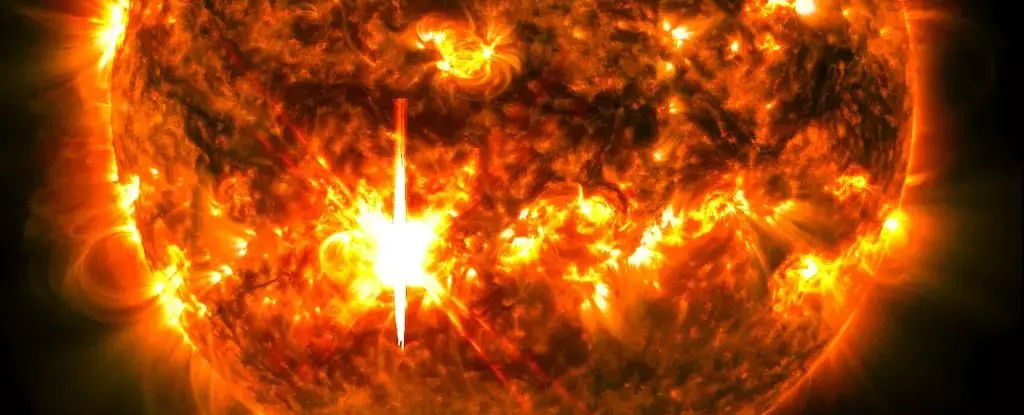As we transition into October, our celestial neighbor—the Sun—has made its presence felt with an extraordinary display of energy. Beginning October 1, this cosmic giant unleashed a formidable X7.1 solar flare coupled with a coronal mass ejection (CME) aimed directly at Earth. This event is noteworthy, not just for its intensity—ranking as the second most powerful flare recorded in this solar cycle—but for its implications on Earth’s space weather. With this stellar dance sparking minor to strong geomagnetic storms expected between October 3 and 5, it presents an intriguing scenario for scientists and the public alike.
Solar flares and CMEs are fascinating phenomena that occur when the Sun is particularly active. This current solar cycle appears to be reaching its peak, resulting in an uptick in such events. Flares are explosive bursts of light and energy emanating from sunspots—regions of concentrated magnetic activity. When these sunspots feature tangled magnetic field lines of opposing polarities, catastrophic energy release occurs. This phenomenon brings a dual threat: while flares can induce short-term radio blackouts on Earth’s sunlit side, CMEs release vast quantities of solar particles, which may collide with Earth’s magnetic field, inducing geomagnetic storms.
These storms primarily affect the upper atmosphere, creating a spectacle in the form of auroras, the breathtaking and colorful displays of light commonly seen near the poles. When solar particles meet the atmosphere, they ionize the gases, leading to these luminous reactions. As such, the recent X7.1 flare has not only posed an interesting scientific case but also sets the backdrop for potentially scintillating auroral displays.
The source of this solar activity, the sunspot region known as AR 3842, is notable for its complexity. Dubbed a Beta-Gamma-Delta region, AR 3842 boasts a chaotic structure of magnetic fields that creates an ideal environment for intense solar eruptions. As this sunspot region continues its journey across the solar disk, it remains in an optimal position for further explosive activity directed towards Earth.
Recent observations confirmed that just hours after the X7.1 flare, an M3.2 flare erupted from AR 3842. Such flares are significant; while they can lead to communication disruptions on Earth, they also generate a sense of anticipation. The thrill of waiting for the subsequent effects of these solar outbursts fuels scientific curiosity, but also presents an opportunity for public engagement with space weather phenomena.
Even though we are safely distanced from any catastrophic risks associated with these solar events, they do remind us of the interconnectedness of solar and terrestrial systems. Scientists and meteorological organizations worldwide monitor these activities closely, disseminating forecasts and warnings about anticipated geomagnetic storms. Institutions such as NOAA’s Space Weather Prediction Center and various international agencies have predicted G3-level geomagnetic storms, hinting at an enchanting potential for auroras on the nights of October 4 and 5.
As these predictions evoke excitement among sky gazers and aurora enthusiasts, it is crucial to acknowledge the ongoing efforts of researchers who strive to understand the complexities of solar activity. The most powerful flare recently noted, an X8.7 event from May, delivered some of the most extraordinary auroral displays to date, a benchmark that many hope will be met or surpassed with the upcoming activity.
As we delve deeper into October, the anticipation for more spectacular cosmic displays intensifies. This year has already marked a remarkable chapter in auroral occurrences, and experts project more fascinating celestial shows as AR 3842 maintains its influence. Utilizing tools such as the Kp Index—which gauges geomagnetic activity—enthusiasts can identify optimal viewing conditions for these natural illuminations.
What makes this season even more enthralling is the blend of science and art; the makeup of geophysical phenomena intertwined with human experience. The dance of solar particles and the Earth’s magnetic shield not only expand our understanding of cosmic phenomena but also inspire awe among those lucky enough to witness this interaction.
The recent solar activity signifies more than just a scientific marvel; it reminds us of the Sun’s vital role in shaping our existence on Earth. As the month progresses, we are reminded that celestial events, however distant, remain connected to our earthly experience. As we look skyward during this spooky season, may we allow ourselves to embrace both the wonder and the science of the cosmos. Each flare and CME is a testament to the elegance of our universe, beckoning us to gaze with curiosity and awareness at the mysteries that lie beyond our atmosphere.


Leave a Reply